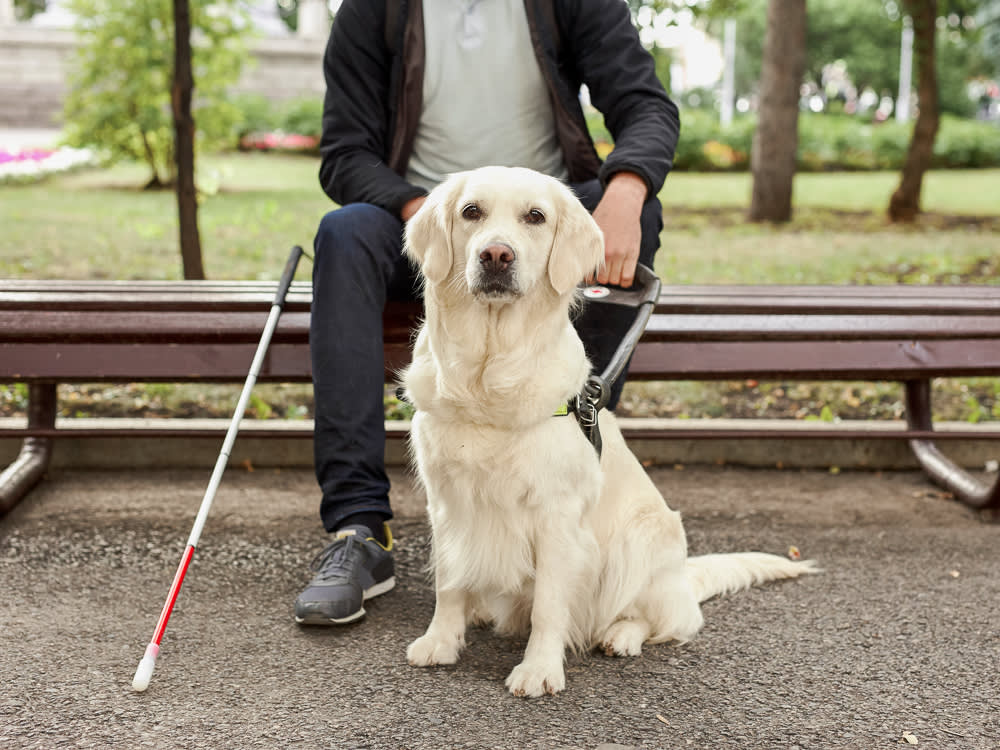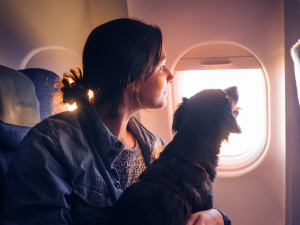10 Misconceptions About Service Dogs and Their Remarkable Partners
No, you can’t pet them when their human isn’t looking.

share article

Your pet wants you to read our newsletter. (Then give them a treat.)
If you see a service dog walking down the street, you definitely want to pet that good boy or girl, but you definitely know you are not supposed to do that. As much as we want to praise these perfect dogs for doing a perfect job, we have to shower them with our undying love from afar. Here are some things you should know about service dogs.
Why do people have service dogs?
Of course we love them, but what precisely is the purpose of service dogs? Why are service dogs important? These days, there are still many misconceptions surrounding service dogs, including who can have them and what they do. Here, we debunk 10 of the most common ones.
1. Are emotional support animals the same as service dogs?
Here are the facts about emotional support animals and how they’re (legally) different than service dogs: An emotional support animalopens in a new tab (ESA dog) is defined as a pet who emotionally supports their handler. With a doctor’s note, ESA dogs can live in no-pets-allowed housing. And until January 2021, they were also allowed to fly in the cabin of an aircraft free of charge. But due to some incidents by people claiming that their pets were emotional support animals, from llamas to peacocks, airlines will now only offer free, unconfined rides to service dogs and certified psychiatric service dogs (PSDs).
A service dog, however, is considered to be medical equipment, no different than, say, a wheelchair or insulin pump. Service dogs must be specifically trained to do work or tasks relating to the mitigation of a person’s disability. Simply offering emotional support and comfort or having a calming effect doesn’t quite fit the bill.
2. Are service dogs always wearing vests or identifiable gear?
Despite many scam sites that claim their products (service dog tags, certificates, or vests) are not only legitimate, but mandatory, in the U.S. there is actually no such thing as a legitimate federal or state identification card or certificate that “proves” a dog is a trained service dog. However, a service animal always wears a vest for identification.
3. Are service dogs only for blind people?
It used to be the case many years ago that it was only service dogs for the blind and service dogs for the deaf. But things have changed dramatically. Today, service dogs are employed by people with mental illnesses, autism, seizures, diabetes, and countless other conditions — anything that affects the person’s capacity to perform at least one major life task. The dog’s purpose is to help the person be more independent.
4. Does training only take a few months?
Technically speaking, training never ends. Service dogs must be able to learn new skills and adapt to their handlers’ needs as they change over time. Additionally, it is not uncommon for fully trained dogs to need brush up on things they’ve already learned how to do. Initially though, it takes about two years to train a service dog.
5. Can service dogs be any breed or size?
Dogs of any breed, shape, or size can potentially be a service dog, provided they are healthy, have a stable temperament, and can be trained to do the necessary work. Many nontraditional breeds — shelter dogs and bully breeds included — make amazing service dogs.
6. Do service dogs know if people are carrying drugs?
Can a service dog smell drugs? Probably. Will they bark and blow your cover? Not likely. Service dogs and detection dogs are trained to respond to completely different things. The only person a service dog focuses on is their handler.
7. Is it okay to pet a service dog (if the handler isn’t looking)?
It’s important to understand why you can’t pet a service dog: In the service-dog community, people who do this are called “drive-by petters.” They wait for the handler to look away, then pet the dog as they walk by. Not only is this disrespectful, it’s also distracting to the dog, who needs to be focused on working. In addition, most states have laws prohibiting interference with or intentionally injuring (or allowing another dog to injure) service dogs.
8. Do people with service dogs want to chat?
No offense, but no, they don’t. They usually just want to, say, get milk at the grocery store and go home rather than indulge a stranger’s curiosity. Just because they have a service dog doesn’t mean they want to share their life story. The next time you see a service dog team out and about, ignore the dog and go about your business — allowing them to go about their business, too.
9. Can businesses require people with service dogs to prove they need them?
According to the federal Americans with Disabilities Actopens in a new tab (ADA), staff may ask two questions: First, is the dog a service animal who is required because of a disability? Second, what work or task has the dog been trained to perform? That’s it. They cannot ask about the person’s disability, require medical documentation, a special identification card or training documentation, or ask that the dog demonstrate the work or task. On the flip side, if a dog acts aggressivelyopens in a new tab or has an accident, a business can ask that the dog be taken off the premises.
10. Can service dogs accompany their handlers everywhere?
Being a working service dogs is arguably one of the best lives a dog could have. They’re able to be with their handlers almost all the time, no matter where they go. They have a job and a purpose, which dogs thrive on. Plus, most get a higher quality of care than many humans. Separation anxiety? I don’t know her!
FAQ (People Also Ask):
1) Can anyone just buy a service dog online?
The ADA defines a service dog as one who is trained to perform a specific action for a person with a disability (which you must have).
2) Can a service dog have two handlers?
A service dog may serve more than one person in the same home, such as a home with more than one child with disabilities. And one person may have more than one service animalopens in a new tab.
3) What to do if a service dog approaches you without their owner?
If a service dog approaches you with no handler in sight, it’s a clue that the dog is seeking help. Follow the dog. They will lead you to their handler. Identify the situation, and if necessary, call 911 immediately.
4) How to get a service or emotional support dog?
A service animal means any dog that is individually trained to do work or perform tasks for the benefit of an individual with a disability. Support dogs do not have special training to perform tasks that assist people with disabilities.
References

Kaelynn Partlow
Kaelynn Partlow was diagnosed with autism and learning disabilities as a child; as an adult, she is a therapist working with autistic children. At Assistance Dogs of the Carolinas, she teaches people with disabilities to train their own service dogs.
Related articles
![Person holding a corgi, shot from behind]() opens in a new tab
opens in a new tabFlying with An Emotional Support Animal
Are ESA alpacas and peacocks mocking people with real disorders? A service-dog owner and flight attendant get real.
![Happy lesbian couple cuddling on the couch with pet dog]() opens in a new tab
opens in a new tabGuess Which Shelter Dogs Make Great Service Dogs
Loyal, devoted, and dutiful, Pit Bulls are proving to be pretty well suited to helping humans in need.
![A redheaded woman in a black hat and sunglasses holding her pug dog under her arm as well as two boarding passes and her passport in an airport hallway]() opens in a new tab
opens in a new tab10 Places Where Your ESA Is — and Is Not — Allowed
Not every public place allows ESAs — but there are ways to advocate for yourself and your needs when your pup or other ESA is not on the guest list.
![A woman holding a cat close to her while sitting on a yoga mat.]() opens in a new tab
opens in a new tabShockingly, Your Pet Will Enhance Your Mindfulness Practice
The next time they try to kiss your face while you’re in corpse pose, let them.
![A woman walking with her dog in a garden.]() opens in a new tab
opens in a new tabHow to Take Your Dog On a Mindful Nature Walk
Wellness experts and animal trainers agree: a tuned-in spring outing can be restorative for both people and pets.
![]() opens in a new tab
opens in a new tabThese Organizations Support Domestic Violence Survivors and Their Pets
Learn how you can support their efforts.









